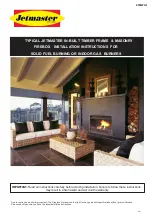
ZEFIRO
3
- ZEN AIRTIGHT
4
• Slightly pull out the machine body from the structure (see
INSERT EXTRACTION a pag. 14
)
• Remove the screws fixed to the base of the insert (see
Fig. 1
) and then remove it from the pallet.
2.3
STOVE HANDLING
Both whether the stove is packed or not it is necessary to observe the following instructions for handling and transporting the
stove from its sale point to its installation point and for any future movements:
• The stove must be handled with idoneous means paying attention to the existing safety regulations;
• do not turn the stove upside down and/or upset it on one side, but keep it in vertical position or as accorded with the construc-
tor instructions;
• if the stove is made up of ceramic, stone, glass or any particularly fragile material components, all must be moved with the
utmost care.
3
CHIMNEY FLUE
3.1
INTRODUCTION
This chapter about the Chimney Flue has been drawn up in cooperation with Assocosma (www.assocosma.org) and is based on
European Standards (EN 15287 - EN 13384 - EN 1856 - EN 1443) and UNI 10683:2012.
It provides instructions for a good and correct execution of the chimney flue but it does not absolutely replace the current stan-
dards which the qualified manufacturer/installer should comply with.
3.2
CHIMNEY FLUE
Fig. 2 - Chimney Flues
LEGEND
Fig. 2
1
Chimney flue with insulated stainless-steel pipes
2
Chimney flue on the existing chimney
3
Inspection plug
4
Inspection door
5
≥ 3,5 mt
• The chimney flue or chimney is of great importance for the correct running of the heating appliance.
• It is fundamental that the chimney flue is perfectly built and always maintained with a perfect efficiency.
• The chimney flue must be sole (see
Fig. 2
) with insulated stainless-steel pipes (1) or installed on the existing chimney flue (2).





































